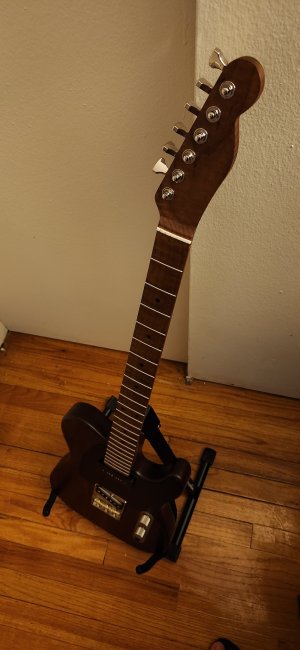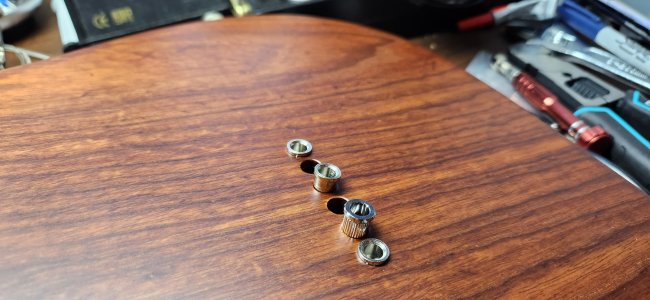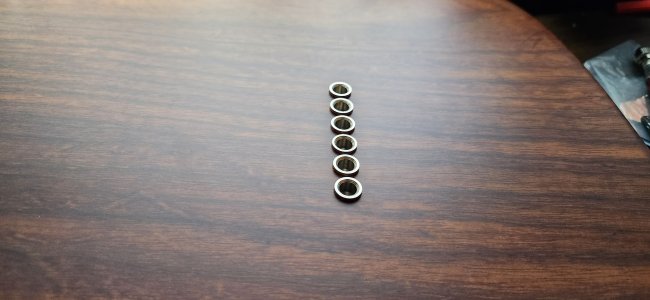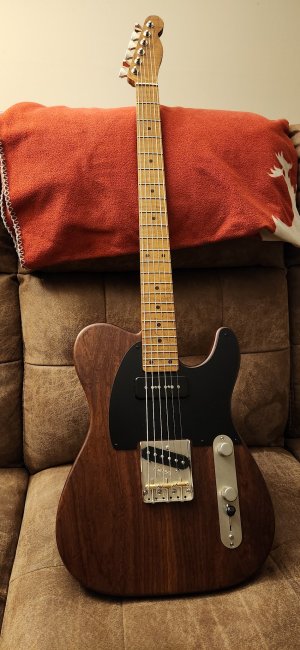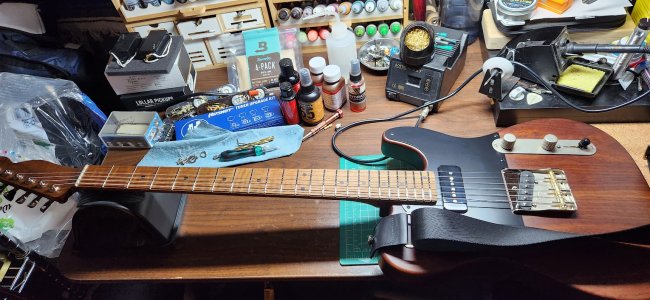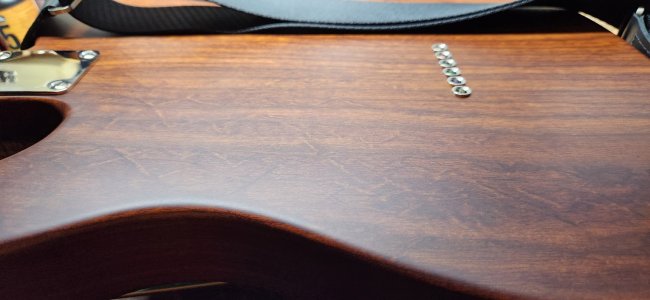I'm in the home stretch of finishing a build that I've been acquiring parts piecemeal for over the past year and a half. I still need to figure out the string ferrule size situation, and see if this thing can intonate.
The build is a Baritone telecaster in roasted swamp ash with a clear satin finish, neck in roasted flame maple - pictured in the center below:
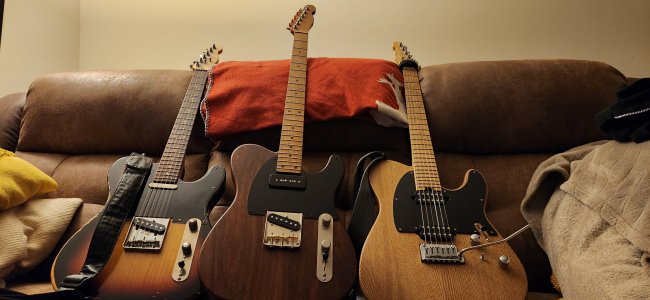

I received the body and there were noticable issues, but the finish in a dim room didn't look cracked, and it seemed mostly okay. I then ordered a Warmoth Baritone Scale Conversion, Telecaster Replacement neck in Roasted Maple. I made a mistake in ordering a finish on the neck, when I was looking for unfinished. I called Warmoth the next day and made the change to an unfinished neck. I waited the build time and received an email back from customer service stating they had wound up putting a finish on the neck and asked how I would like to handle it.
I had no issue with customer service, they were great throughout the process - I was looking for an unfinished neck though so they let me reorder and I think they took care of me because I upgraded to roasted flamed maple on roasted flame maple:
Construction
Baritone Scale Conversion
Shaft Wood
Roasted Flame Maple
Fretboard Wood
Roasted Flame Maple
Nut Width
1-11/16" (43mm) - Modern Medium
Right / Left Handed
Right-Handed
Neck Back Profile
Standard Thin
Fretboard Radius
10" - 16" Compound
Number of Frets
24
Fret Size & Material
SS6150 - Wide & Tall (Stainless)
Tuner Hole Size
Planet Waves (13/32")
Inlay Shape
Standard Dots
Inlay Material
Black
Side Dots
Black Side Dots
String Nut
Standard Nut - GraphTech White TUSQ XL
Mounting Holes
Standard 4-Bolt
Neck Heel Shape
Tele® Shape
Finish
None
I received the neck ahead of schedule, and then it came time to build out the original plan - I ran into a few snags trying to use the eBay parted out Fender Player II body, and some of the associated hardware:
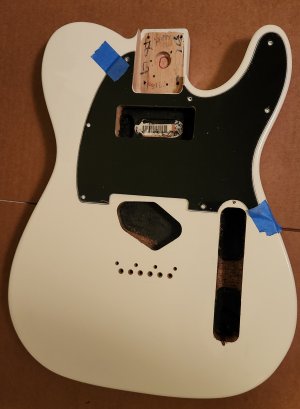
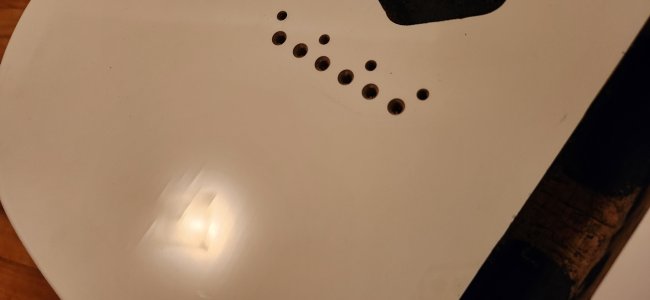
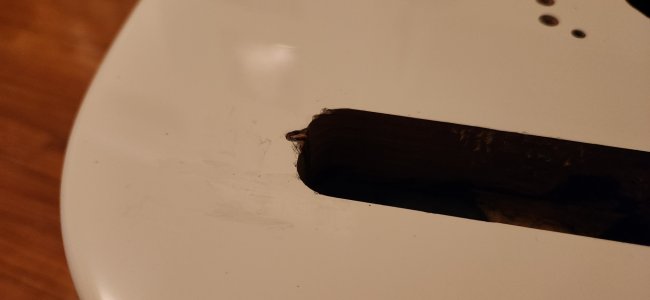
Needless to say this guitar body had not worked out for me even after putting some work into it. That Warmoth neck in roasted flame maple was also looking so good at this point finished with a single coat of tru-oil buffed down, followed by a single coat of tru-oil wax buffed down.
I convinced myself it didn't look right when paired with the body, the blemishes on the body drew my eye and I knew I wouldn't be happy with it.
I shelved the Olympic White Telecaster body, took the L, and ordered a Warmoth Telecaster Replacement Body with a satin clear finish over roasted swamp ash to further drop down the affordability:
Construction
Solid
Core Wood
Roasted Swamp Ash
Lam Top Wood
No Lam Top
Right / Left Handed
Right-Handed
Control Cavity
Top Rout
Neck Pickup Rout
P90
Middle Pickup Rout
None
Bridge Pickup Rout
Tele®
Jack Rout
7/8" (22mm) Side Jack Hole
Bridge Rout Type
Hardtail
Bridge Rout
Vintage Telecaster®
Mounting Holes
Standard 4-Bolt
Neck Pocket Shape
Tele®
Body Contours
None
Binding and Edge Decorations
None
Battery Box
None
Paint Category
Clear
Top Color
Clear
Back Color
Clear
Satin or Gloss
Satin
I was wiring up a control plate at this point to drop in and was having issues with cold solder joints, and soldering to pots. I have always had issues with soldering especially soldering to pots. I've always attributed it to not being good at soldering, but I never really had an issue with making cold solder joints and having such difficulty with how my solder was flowing but was running out of patience and good potentiometers.
I took another affordability hit and wound up ordering a pre-wired control plate out of frustration. I received the pre-wired control plate, but I still need to solder connections and. I've had the same big roll of random brand 60/40 leaded solder forever - why not get a small roll of the Kester 44 63/37 I've seen mentioned and just see if it helps. Well it really did help, I had no issues with heat transfer or soldering to pots. I didn't have to use any extra flux on the pots, just what was already in the Kester 44. I still suck at soldering but it definitely made an improvement for me.
If you look carefully in the messy hobby table photo below you can see some Radio Shack solder to give an idea of how long I've had my solder, and also the tube of super glue that couldn't contain itself on the other guitar body:

Some dark photos:
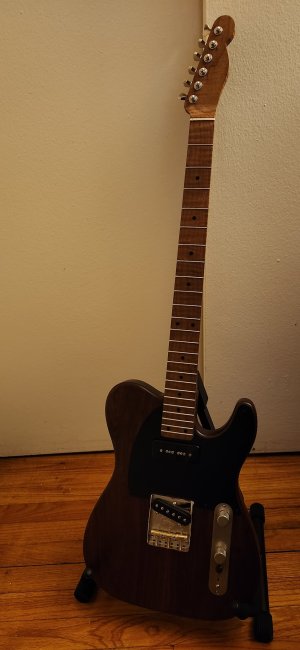

The build is a Baritone telecaster in roasted swamp ash with a clear satin finish, neck in roasted flame maple - pictured in the center below:

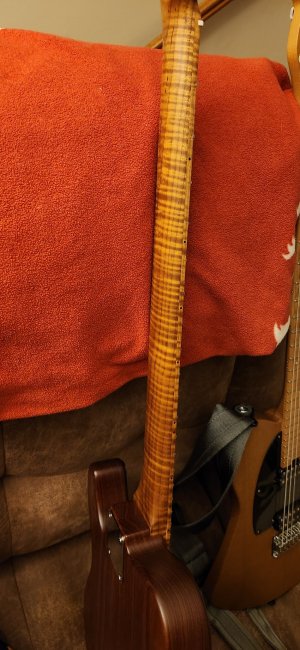

Where it started:
The build started out as a plan to build a relatively affordable baritone telecaster, using an Olympic White Telecaster body, acquired from a parted out Fender Player II tele on eBay that had most hardware minus the control plate and pickups. Affordable went out the window when I went with a Fralin Hum-Canceling P90 with Alnico Rods in the neck position, and a Fralin Split Steel Poled Tele in the bridge position.I received the body and there were noticable issues, but the finish in a dim room didn't look cracked, and it seemed mostly okay. I then ordered a Warmoth Baritone Scale Conversion, Telecaster Replacement neck in Roasted Maple. I made a mistake in ordering a finish on the neck, when I was looking for unfinished. I called Warmoth the next day and made the change to an unfinished neck. I waited the build time and received an email back from customer service stating they had wound up putting a finish on the neck and asked how I would like to handle it.
I had no issue with customer service, they were great throughout the process - I was looking for an unfinished neck though so they let me reorder and I think they took care of me because I upgraded to roasted flamed maple on roasted flame maple:
Construction
Baritone Scale Conversion
Shaft Wood
Roasted Flame Maple
Fretboard Wood
Roasted Flame Maple
Nut Width
1-11/16" (43mm) - Modern Medium
Right / Left Handed
Right-Handed
Neck Back Profile
Standard Thin
Fretboard Radius
10" - 16" Compound
Number of Frets
24
Fret Size & Material
SS6150 - Wide & Tall (Stainless)
Tuner Hole Size
Planet Waves (13/32")
Inlay Shape
Standard Dots
Inlay Material
Black
Side Dots
Black Side Dots
String Nut
Standard Nut - GraphTech White TUSQ XL
Mounting Holes
Standard 4-Bolt
Neck Heel Shape
Tele® Shape
Finish
None
I received the neck ahead of schedule, and then it came time to build out the original plan - I ran into a few snags trying to use the eBay parted out Fender Player II body, and some of the associated hardware:
- The neck pocket in the Fender Player II tele body is not standard, the Warmoth neck that was 100% within spec - did not fit this neck pocket. About 1mm of material had to be removed all around the neck pocket to make a tight fit. A hairline crack formed in the thin finish as a result of the work in the neck pocket.
- The bridge pickup route must save Fender 50 cents a year of runtime on their CNC machines - it took some chiseling and sanding to fit any of the bridge pickups I had around comfortably.
- The control cavity hump had to be removed because I wire telecaster control plates like those spring loaded joke cans of fake peanuts
- The control cavity itself is on a slight angle so the control plate isn't parallel with a bridge installed which I didn't notice at first.
- The 6-saddle bridge that the Fender Player II body came with was not compatible with the Fralin Split Steel Poled Tele bridge pickup size-wise.
- There wasn't a great route to use for a bridge ground.
- Pickguard screw holes are kind of wild.

- There are cracks in the clear coat that are very noticeable in direct light, below the bridge:

- The pre-drilled mounting screw holes are absolutely wild. I taped everything off around the control plate and started working on filling them. I had a disaster moment squeezing a super glue tube past all of the painter's tape and onto the finish below the control plate - it did some damage to the clear coat removing it, and some of the existing shielding paint dust mixed in as well:

Needless to say this guitar body had not worked out for me even after putting some work into it. That Warmoth neck in roasted flame maple was also looking so good at this point finished with a single coat of tru-oil buffed down, followed by a single coat of tru-oil wax buffed down.
I convinced myself it didn't look right when paired with the body, the blemishes on the body drew my eye and I knew I wouldn't be happy with it.
I shelved the Olympic White Telecaster body, took the L, and ordered a Warmoth Telecaster Replacement Body with a satin clear finish over roasted swamp ash to further drop down the affordability:
Construction
Solid
Core Wood
Roasted Swamp Ash
Lam Top Wood
No Lam Top
Right / Left Handed
Right-Handed
Control Cavity
Top Rout
Neck Pickup Rout
P90
Middle Pickup Rout
None
Bridge Pickup Rout
Tele®
Jack Rout
7/8" (22mm) Side Jack Hole
Bridge Rout Type
Hardtail
Bridge Rout
Vintage Telecaster®
Mounting Holes
Standard 4-Bolt
Neck Pocket Shape
Tele®
Body Contours
None
Binding and Edge Decorations
None
Battery Box
None
Paint Category
Clear
Top Color
Clear
Back Color
Clear
Satin or Gloss
Satin
I was wiring up a control plate at this point to drop in and was having issues with cold solder joints, and soldering to pots. I have always had issues with soldering especially soldering to pots. I've always attributed it to not being good at soldering, but I never really had an issue with making cold solder joints and having such difficulty with how my solder was flowing but was running out of patience and good potentiometers.
I took another affordability hit and wound up ordering a pre-wired control plate out of frustration. I received the pre-wired control plate, but I still need to solder connections and. I've had the same big roll of random brand 60/40 leaded solder forever - why not get a small roll of the Kester 44 63/37 I've seen mentioned and just see if it helps. Well it really did help, I had no issues with heat transfer or soldering to pots. I didn't have to use any extra flux on the pots, just what was already in the Kester 44. I still suck at soldering but it definitely made an improvement for me.
If you look carefully in the messy hobby table photo below you can see some Radio Shack solder to give an idea of how long I've had my solder, and also the tube of super glue that couldn't contain itself on the other guitar body:

Some dark photos:





